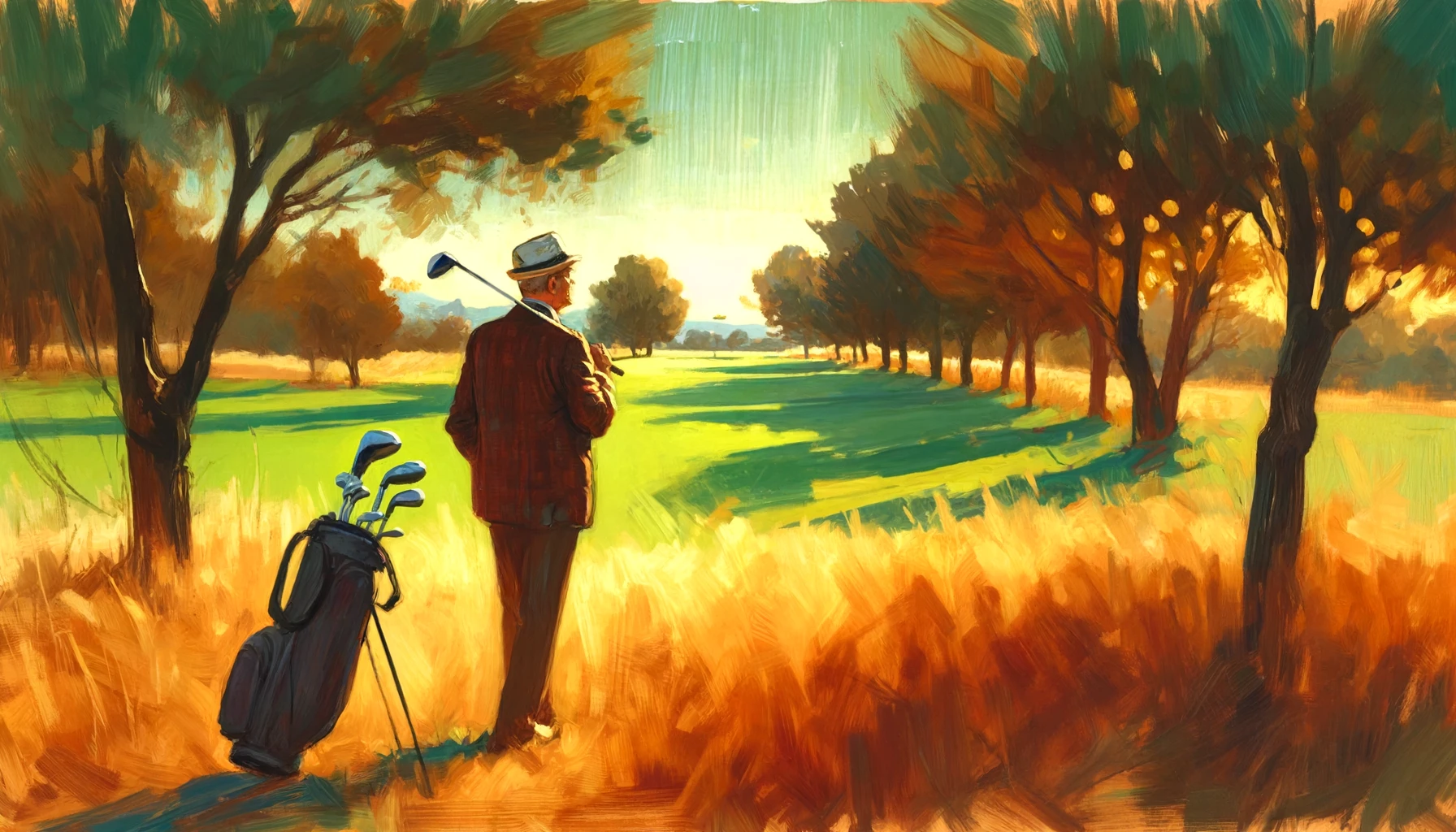- Home
- Moe Norman
- One Plane Swing
The Lazy Golfer's Guide to Mastering the One Plane Swing
Are you tired of being the butt of the jokes on the golf course? Do you dream of hitting long, straight shots that leave your buddies in awe? If so, I've got something that might just be your secret weapon on the golf course. It's called the one plane swing, and it's a game-changer.
Imagine stepping up to the first tee, confident and relaxed. You take your stance, swing your club, and watch as the ball sails down the fairway, straight and true. Your buddies are speechless. You can't help but grin.
That's the power of the one plane swing.
But it's not just about impressing your friends. The one plane swing can help you lower your score, hit more consistent shots, and truly enjoy your time on the course. It's a simple, repeatable method that's less physically demanding than traditional swings.
Perfect for us lazy golfers, right?
So, are you ready to transform your golf game? Ready to step up to the tee with confidence, knowing you've got a secret weapon in your golfing arsenal?
Then stick around.
I'm about to show you how to master the one plane swing.
Let's get started.
The One Plane Swing: Your Secret Weapon on the Golf Course
Are you a golfer whose inconsistency has become the butt of jokes at the first tee?
Do you dream of launching long, arrow-straight shots that leave your buddies speechless?
If this resonates with you, then the one plane swing could be the secret arsenal you need on the golf course. But what is this one plane swing, and how can it revolutionize your game?
The one plane swing is a method of swinging the golf club that has been popularized by golf pros like Jim Hardy. It's all about simplicity and consistency.
In a one plane swing, the position of your left arm (for right-handers) at the top of your backswing matches the tilt of your shoulders. This alignment creates a single, unified plane of motion for your swing, hence the name "one plane swing."
But how does it compare to the more traditional two plane swing?
In a two plane swing, the arm and shoulder planes are different, leading to a more complex motion. While some golfers prefer the two plane swing, others find the simplicity of the one plane swing easier to master and repeat.
Are you all getting this?
Good, let's move on.
The Pros and Cons of the One Plane Swing
Like any golf technique, the one plane swing has its pros and cons.
On the plus side, its simplicity makes it easier to repeat, leading to more consistent shots. It's also less physically demanding, making it a good choice for golfers who don't have the time or inclination to practice extensively.
On the downside, the one plane swing can be challenging to master initially, especially for golfers used to a two plane swing. It also requires a good understanding of golf mechanics to execute correctly.
But don't let these challenges deter you. With practice and the right guidance, you can master the one plane swing and start hitting those long, straight shots you've been dreaming of.
Isn't that exciting?
How to Practice the One Plane Swing
So, how do you go about mastering the one plane swing? Here are some practical tips and drills:
1. Alignment: Start by ensuring your body is correctly aligned. Your feet, hips, and shoulders should all be parallel to the target line.
2. Posture: Maintain a good posture throughout your swing. Your spine should be straight, and your weight should be evenly distributed between your feet.
3. Swing Plane: Practice swinging the club on a single plane. A good drill for this is to place a rod or stick along the line of your golf club and practice swinging along this line.
4. Consistency: The key to a successful one plane swing is consistency. Practice your swing regularly to build muscle memory and ensure a smooth, consistent motion.
Remember, the goal is not to perfect your swing overnight but to gradually improve over time. So be patient with yourself and enjoy the process.
After all, you're finally ready for success, aren't you?
The One Plane Swing and Golf Equipment
Now, let's talk about golf equipment.
As an avid golfer, you know the thrill of getting new golf gear. But did you know that the right equipment can also help improve your one plane swing?
For instance, using a golf club with the right shaft length and flex can make a big difference in your swing. A club that's too long or too stiff can throw off your swing plane, making it harder to execute a consistent one plane swing.
So, don't be afraid to experiment with different clubs and find the one that works best for you.
Your Path to Golfing Success
The one plane swing offers a simple, repeatable method for hitting long, straight shots. Whether you're a weekend golfer looking to impress your buddies or a more serious player aiming to lower your score, mastering the one plane swing can be a game-changer.
Remember, the key to success is practice and consistency. So, why not give the one plane swing a try?
With time and patience, you might just find yourself hitting those 2500-yard howitzer shots off every tee. And wouldn't that be something to brag about in the clubhouse?
Key Takeaways
1. The one plane swing is a simple, repeatable golf swing method that aligns the position of your arm and shoulders in a single plane of motion.
2. The one plane swing can lead to more consistent shots and is less physically demanding, making it a good choice for golfers who don't have the time or inclination to practice extensively.
3. Mastering the one plane swing requires understanding of golf mechanics, correct alignment and posture, and regular practice.
4. The right golf equipment can aid in executing a successful one plane swing.
So, are you ready to transform your golf game with the one plane swing?
Onward to golfing success!
Frequently Asked Questions about the One Plane Swing
What is a one plane swing?
What is a one plane swing?
A one plane swing is a golf swing method that involves keeping the club and the hands on a single plane throughout the swing. This means the club shaft is kept on the same angle throughout the swing, which is usually a flatter plane than a traditional swing.
Who created the one plane swing?
Who created the one plane swing?
The one plane swing method was developed by Jim Hardy. However, it was made significantly more popular and common by the great Moe Norman.
How does the one plane swing differ from a "normal" swing?
How does the one plane swing differ from a "normal" swing?
The one plane swing creates a more shallow swing plane by creating a flatter plane compared to a two plane backswing. In a one plane swing, the left arm's position at the top of the backswing matches the tilt of the shoulders when viewed looking down the target line.
How do I achieve the correct one plane golf swing?
How do I achieve the correct one plane golf swing?
To achieve the correct one plane golf swing, you need to start from a slightly more bent over address of the ball. This means you've got to be a little more bent over from the waist.
What are the pros and cons of the one plane swing?
What are the pros and cons of the one plane swing?
The one plane swing can lead to more consistent shots and is less physically demanding, making it a good choice for golfers who don't have the time or inclination to practice extensively. However, it may take some time to master and may not be suitable for all golfers depending on their physical capabilities and personal preferences.
What is a single plane golf swing?
What is a single plane golf swing?
A single plane golf swing is another term for a one plane swing. It involves keeping the club and the hands on a single plane throughout the swing.
What is a two-plane golf swing?
What is a two-plane golf swing?
In a two-plane swing, the left arm is typically higher (more upright or vertical) at the top of the backswing. In other words, it's above the shoulder plane. This is in contrast to the one plane swing where the left arm's position matches the tilt of the shoulders.
How can I transition from a two-plane swing to a one plane swing?
How can I transition from a two-plane swing to a one plane swing?
Transitioning from a two-plane swing to a one plane swing involves adjusting your stance and swing mechanics. It's recommended to seek guidance from a golf instructor or coach to ensure you're making the correct adjustments.
What equipment is best for a one plane swing?
What equipment is best for a one plane swing?
The best equipment for a one plane swing is largely dependent on the individual golfer's preferences and physical capabilities. However, clubs with a flatter lie angle may be more suitable for a one plane swing.
Can the one plane swing help me hit longer drives?
Can the one plane swing help me hit longer drives?
Yes, the one plane swing can help you hit longer drives. By creating a more efficient swing plane, you can generate more power and distance in your shots. However, it's important to remember that technique and consistency are key to hitting longer drives.
Is the one plane swing suitable for beginners?
Is the one plane swing suitable for beginners?
The one plane swing can be suitable for beginners due to its simplicity and repeatability. However, it's important for beginners to receive proper instruction and practice regularly to develop a consistent and effective one plane swing.
What are some common mistakes when performing a one plane swing?
What are some common mistakes when performing a one plane swing?
Common mistakes when performing a one plane swing include not maintaining a consistent plane throughout the swing, not properly aligning the body at address, and not rotating the body effectively during the swing. It's important to seek guidance from a golf instructor or coach to avoid these mistakes and ensure you're performing the one plane swing correctly.
What are some exercises to improve my one plane swing?
What are some exercises to improve my one plane swing?
There are several exercises that can help improve your one plane swing, including flexibility exercises to improve your range of motion, strength training exercises to increase your power, and balance exercises to improve your stability during the swing. It's recommended to incorporate these exercises into your regular fitness routine to see improvements in your one plane swing.
How can I practice the one plane swing at home?
How can I practice the one plane swing at home?
You can practice the one plane swing at home by performing dry swings or using a golf training aid. It's important to focus on maintaining a consistent swing plane and properly rotating your body during the swing. You can also use a mirror or video recording to check your form and make necessary adjustments.
Can the one plane swing help me lower my golf score?
Can the one plane swing help me lower my golf score?
Yes, the one plane swing can help you lower your golf score by leading to more consistent and accurate shots. However, it's important to remember that improving your golf score involves more than just your swing technique. Factors such as course management, putting, and mental game also play a significant role.
What is the difference between a one plane swing and a single plane swing?
What is the difference between a one plane swing and a single plane swing?
There is no difference between a one plane swing and a single plane swing. These terms are used interchangeably to describe the same swing method.
How can I tell if I'm doing the one plane swing correctly?
How can I tell if I'm doing the one plane swing correctly?
You can tell if you're doing the one plane swing correctly by checking your form at various points during the swing. At the top of the backswing, your left arm (for right-handed golfers) should match the tilt of your shoulders when viewed from behind. If you're unsure, it's recommended to seek feedback from a golf instructor or coach.
What are some tips for mastering the one plane swing?
What are some tips for mastering the one plane swing?
Some tips for mastering the one plane swing include practicing regularly, focusing on maintaining a consistent swing plane, properly aligning your body at address, effectively rotating your body during the swing, and seeking guidance from a golf instructor or coach.
Can the one plane swing help me hit straighter shots?
Can the one plane swing help me hit straighter shots?
Yes, the one plane swing can help you hit straighter shots by creating a more efficient and repeatable swing plane. This can lead to more consistent ball striking and improved accuracy.
What are the benefits of the one plane swing?
What are the benefits of the one plane swing?
The benefits of the one plane swing include more consistent and accurate shots, less physical strain, and a simpler, more repeatable swing mechanics. These benefits can lead to improved performance on the golf course and a lower golf score.
Is the one plane swing better than the two plane swing?
Is the one plane swing better than the two plane swing?
Whether the one plane swing is better than the two plane swing largely depends on the individual golfer. Some golfers may find that the one plane swing suits their physical capabilities and personal preferences better, while others may prefer the two plane swing. It's recommended to try both swing methods and see which one works best for you.










